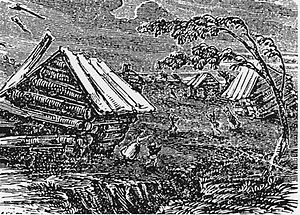1811–1812 New Madrid earthquakes

This refers to a series of earthquakes near the town of New Madrid, in late 1811, and early 1812. They are known as the 1811–12 New Madrid earthquakes. The town is right next to the Mississippi River. This was the largest earthquake known in the United States in recorded history.[1]
The first shock was on December 16, 1811. It had a magnitude of 7.5-7.9 on the Richter scale. There also was an aftershock of magnitude 7.4 on the same day. They were the most powerful earthquakes to hit the contiguous United States east of the Rocky Mountains in recorded history.[2][3][4] We use the word "contiguous" because we wish to exclude Hawaii and Alaska, neither of which was then part of the United States.
The earthquakes occurred in and near the Mississippi River town of New Madrid. The town was part of the Louisiana Territory at the time. Today, it is in the US state of Missouri.

There are estimates that these stable continental region earthquakes were felt strongly over an area of 50,000 square miles (130,000 km2), and moderately across nearly 3 million km2 (1 million sq mi). The 1906 San Francisco earthquake, by comparison, was felt moderately over roughly 16,000 km2 (6,200 sq mi). There were in all three earthquakes, and each had major aftershocks.[5]
Different American Indian tribes interpreted these earthquakes, and came to a consensus: the powerful earthquake had to have meant something. For many tribes in Tecumseh's pan-Indian alliance, it meant that Tecumseh and his brother the Prophet must be supported.[6]
Seismic zones
[change | change source]Even today, earthquakes happen in this area, known as the New Madrid Seismic Zone (or NMSZ). Scientists think that before 2050 there is a chance of over 90% that quakes with a magnitude of over 7.0 on the Richter scale will occur there. Arthur C. Clarke wrote a story called Richter 10, where he describes a scenario like this.
Other seismic activity is known from fault zones within tectonic plates. They include the Charleston earthquake on in 1886. This was particularly surprising as the area had almost no history of even minor earthquakes.
References
[change | change source]- ↑ "U.S. Geological Survey: Largest Earthquakes in the United States". Archived from the original on December 13, 2016. Retrieved August 28, 2017.
- ↑ "U.S. Geological Survey: Largest Earthquakes in the United States". Archived from the original on 2016-12-13. Retrieved 2018-05-05.
- ↑ Historic Earthquakes New Madrid Earthquakes 1811–1812USGS Archived June 8, 2011, at the Wayback Machine
- ↑ The Enigma of the New Madrid Earthquakes of 1811–1812. Johnston A.C. & Schweig E.S. Annual Review of Earth and Planetary Sciences, Volume 24, 1996, pp. 339–384. Available on SAO/NASA Astrophysics Data System (ADS)
- ↑ Conevery Bolton Valencius, “Accounts of the New Madrid earthquakes: personal narratives and seismology over the last two centuries,” in Deborah R. Coen, ed., "Witness to Disaster: Earthquakes and Expertise in Comparative Perspective," *Science in Context*, 25, no. 1 (February 2012): 17-48.
- ↑ John Ehle (1988). Trail of Tears: The Rise and Fall of the Cherokee Nation. pp. 102–4. ISBN 0385239548. (page numbers may be for a different printing.)
